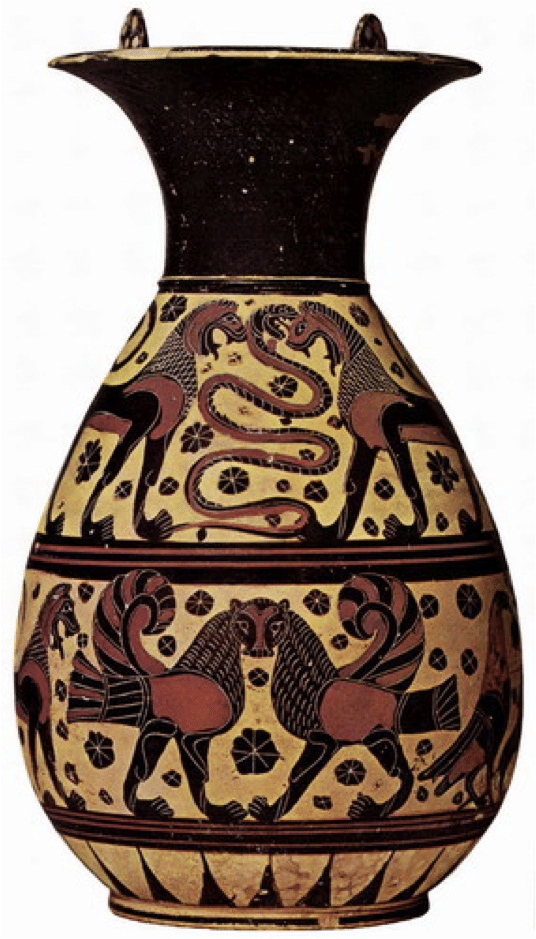5 Ancient Greek Pottery Decoration Reasons

Ancient Greek pottery is not only an exquisite relic from history but also a canvas reflecting the cultural, social, and artistic evolution of one of the world's most influential civilizations. The decorative elements on these pottery pieces serve multiple purposes beyond mere aesthetic appeal. Let's delve into the five ancient Greek pottery decoration reasons that highlight their significance:
Purpose 1: Storytelling Through Mythology


The pottery of ancient Greece often served as a medium for storytelling, particularly through mythological tales. The intricate designs captured the adventures, exploits, and fates of gods, heroes, and legendary creatures, preserving and transmitting cultural knowledge and values. Here’s how:
- Visual Narratives: Scenes from well-known myths like the Labors of Heracles, the adventures of Theseus, or the tales of gods like Zeus and Athena were depicted in vivid detail.
- Education: Through these images, children and illiterate members of society learned about Greek myths, which were integral to their education in virtues, morals, and historical narratives.
- Religious Practices: Pottery with mythological scenes might have been used in religious ceremonies or placed in graves, linking the deceased with the divine or mythical.
Purpose 2: Social Commentary and Satire


Ancient Greek pottery was also a platform for social commentary:
- Political Satire: Artists often portrayed political figures or events in satirical ways, providing a visual form of critique that could be less direct and thus safer than written or spoken commentary.
- Moral Lessons: Images often reflected societal norms, criticizing behaviors or showcasing ideals of virtue, particularly in the use of wine, athletics, or the roles of men and women.
- Humor: Everyday life was depicted humorously, often exaggerating human behaviors for comedic effect, similar to modern-day political cartoons or caricatures.
Purpose 3: Display of Artistic and Technical Skill


Greek pottery decoration was also a showcase of artistic prowess:
- Black-figure and Red-figure Technique: These techniques evolved over time, showcasing the artist’s ability to manipulate clay and pigment to create depth, movement, and realism.
- Innovative Compositions: Artists challenged themselves with complex compositions involving multiple figures, landscapes, and sometimes, architectural elements.
- Technological Advancement: The development and mastery of techniques like the use of a potter’s wheel and firing processes allowed for more elaborate designs and larger forms.
Purpose 4: Symbolic and Religious Significance


Pottery was integral to many religious and ceremonial functions:
- Sacred Symbols: Symbols like the meander (key pattern), palmettes, or lotuses were not merely decorative but carried symbolic meanings related to life, death, and the afterlife.
- Religious Vessels: Special pottery like lekythoi (oil containers) were used in funerary practices, decorated with scenes of mourning, processions, or images related to the underworld.
- Ritual Use: Pottery with specific symbols or depictions was utilized in rituals or as votive offerings in sanctuaries to honor gods or commemorate events.
Purpose 5: Representation of Daily Life and Trade


Lastly, pottery decorations often provided insights into daily life and trade:
- Work and Leisure: Scenes depicted artisans at work, market scenes, or citizens enjoying symposia (drinking parties), providing a glimpse into the social fabric of ancient Greece.
- Economic Activities: Pottery was a significant trade item; its decoration could indicate origin, purpose, or even the maker, serving as a form of branding or quality assurance.
- Cultural Exchange: With the expansion of Greek trade networks, pottery showed cultural influences, blending Greek motifs with those from other Mediterranean cultures, reflecting the cosmopolitan nature of the ancient world.
📜 Note: Greek pottery served as a comprehensive historical record, capturing the essence of Greek civilization in its social, political, artistic, and spiritual dimensions.
In summary, the decorative elements on ancient Greek pottery were not merely ornamental; they were integral to the vessel's purpose and significance. From storytelling through mythological themes to providing commentary on society, showcasing artistic innovation, or serving religious functions, these decorations offer a window into the multifaceted world of ancient Greece. Whether as a medium for education, a form of satire, a showcase of technical skill, or a means to participate in religious and social life, Greek pottery decorations have left a lasting imprint on the world, immortalizing the values, beliefs, and artistic achievements of this ancient civilization.
What are some common mythological scenes depicted on Greek pottery?

+
Some common scenes include the labors of Heracles, the adventures of Odysseus, the myth of Perseus and Medusa, and the exploits of various gods like Zeus, Athena, and Dionysus.
How did the black-figure and red-figure techniques develop in Greek pottery?

+
The black-figure technique, used from around 700 BCE, involved painting figures in silhouette on the raw clay and then incising details. The red-figure technique, which emerged around 530 BCE, reversed this process by allowing details to be painted directly onto the figures, providing a more naturalistic representation with more color and depth.
Why were meanders and other patterns used in pottery decoration?

+
Meanders, palmettes, and other geometric patterns were not only decorative but symbolic. They often represented water, life’s continuity, or the afterlife, providing depth to the pottery’s meaning and use.
How did Greek pottery influence the art of subsequent cultures?

+
Greek pottery influenced later cultures like the Etruscans, Romans, and even the Renaissance artists with its techniques, iconography, and narrative style, shaping the development of Western art.



